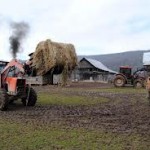Our Food Supply System Adds to Global Warming
Commentary by S. Tom Bond, Resident Farmer of Lewis County, WV
We have now seen black carbon elevated to the second most serious cause of global warming, displacing agriculture, in part due to an article in the Journal of Geophysical Research. Fossil fuel carbon dioxide is the leading cause, as everyone knows.
Agriculture is what we want to look at here. If you read the extreme press, cows take a lot of blame. (In the interest of full disclosure, I’m a cow farmer.) Much of that is due to how they are raised today. More on that later. Lets look at the big picture first.
It takes ten calories of fossil fuels to put one food calorie on your plate. Also, the average item on your plate has traveled 1600 miles. How can that be? I’ll try to answer both at once. The food is harvested by machines and hauled to market. From there it goes to the buyer’s processing plant, where fossil fuels are used to process it for storage and to package it. Then it is moved to the distributor (think Kroger) for storage, perhaps again to some point where it can be sent (fifth trip) to your store. If it is converted to some product like bread or vinegar or ice cream, that puts another trip between production of the raw food and consumption.
Wheat and other small grains are grown in the high plains area, citrus comes from a warm climate, and potatoes come from a cool one. Bananas, pineapple, coconut, and chocolate come from the tropics, grapes in winter come from South America. This diversification and variety is all made possible by cheap energy, almost entirely fossil fuels. However, the fuel has been so cheap in the past that it has encouraged sales to the wealthy part of the world of a diverse, season-independent food supply, and concentration of control. Two things have driven it: the customers desire for novelty in diet and the urge to concentrate capital — larger and larger businesses have driven out smaller ones.
Now, back to cows. Cattle were domesticated in the Middle East. It is now known that all the world’s cattle are descended from a founding herd which had only about 80 female animals. This species emerged because the cattle were able to thrive on grass in the warm part of the year and survive on straw in the winter. The world’s cattle breeds are quite diverse today, from tropics to the far North and they are constantly being modified to improve production. Everywhere, however, they are grass harvesters. They can harvest grass in areas that are too arid, too swampy and too hilly for other kinds of farm production.
Today most cattle go through a finishing lot. Calves from 300 to 700 pounds which have previously eaten only mother’s milk and grass are taken into a lot without grass and fed a corn and soya bean diet to make them grow and get fat. This got started after WWII when there was a huge excess of grain in the West. Magazines from the time showed huge piles of grain dumped out in the open, on tarps, because there was no storage for it. Fat was associated with young animals, and there was a demand for fat, considered fancy beef.
Today it is the standard product. The fat is more saturated and it must be cooked a little more. And more methane is belched in this feeding regimen than if the animal grew on grass. The feed usually contains tetracycline antibiotic, and these animals almost invariably have estrogen-like growth hormones implanted in one ear. It is quite a different product from pre-WWII beef, which you can still buy directly from a local farmer.
A lot of fossil fuel goes into producing that grain. Now half the US production of corn goes into fuel, making it three times as expensive as it was a few years ago, so cattle feeders lost $85 a head finishing cattle last year, according to the Western Livestock Journal.
How to reduce global warming from agriculture? Get rid of “factory farming” and encourage local production, rather than centralization and redistribution of food on a very large scale. This means diet would depend on locality, as it once did. It means timely delivery of fresh food when it is produced. It means seasonality of fruit and most vegetables. And more thinking on the part of the consumer. Perhaps this will be forced on us when the fuels versus global warming problems becomes sufficiently advanced.


{ 2 comments… read them below or add one }
FROM Mother Jones magazine:
Elizabeth Royte has described the direct links between hydraulic fracturing, or fracking, and the food supply. In short, extracting natural gas from rock formations by bombarding them with chemical-spiked fluid leaves behind fouled water—and that fouled water can make it into the crops and animals we eat.
But there’s another, emerging food/fracking connection that few are aware of. US agriculture is highly reliant on synthetic nitrogen fertilizer, and nitrogen fertilizer is synthesized in a process fueled by natural gas. As more and more of the US natural gas supply comes from fracking, more and more of the nitrogen fertilizer farmers use will come from fracked natural gas.
If Big Ag becomes hooked on cheap fracked gas to meet its fertilizer needs, then the fossil fuel industry will have gained a powerful ally in its effort to steamroll regulation and fight back opposition to fracking projects.
http://mobile.alternet.org/alternet/#!/entry/the-surprising-connection-between-food-and-fracking,510f1706d7fc7b567015e8ac
Yes, more contamination in the gas fields means more contamination in the farm fields. The press to produce more corn is so that it can be used to make ethanol, the dilutant for gasoline. Petroleum production, industrial farming, chemical companies and pollution all go together.